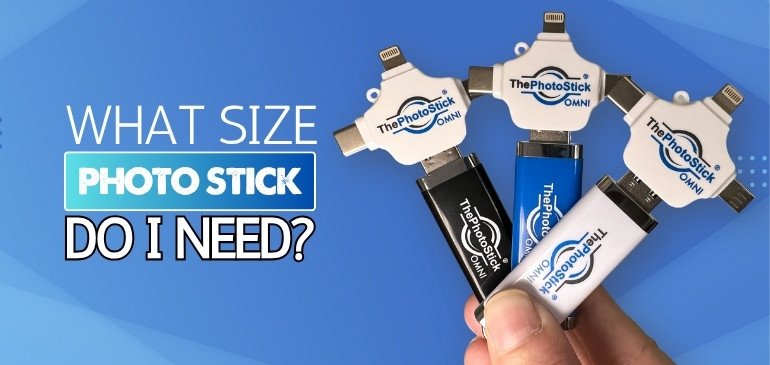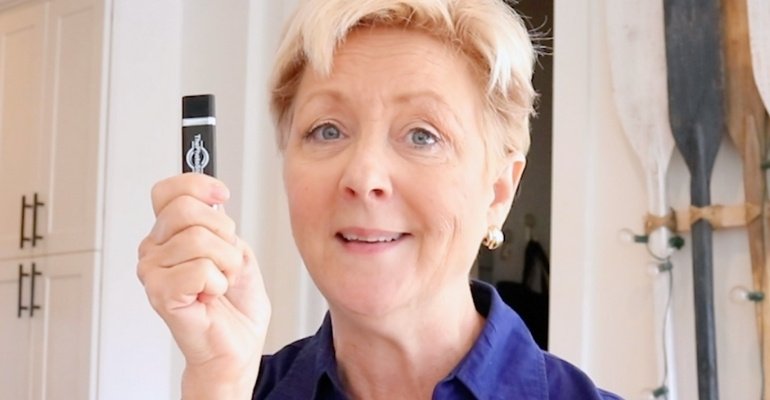We all love taking photos of family moments, vacations, or even random selfies. But over time, our phones and computers can get full. That’s where a photo stick comes in. It’s a small, easy-to-use device that helps you save and back up your pictures and videos.
So, what size photo stick do I need?
If you only have a few thousand photos, an 8GB or 32GB stick should work. For regular use, go for 64GB or 128 GB. But if you take lots of high-quality photos or videos, you might need 256GB, 512GB, or even 1 TB.
Want help picking the right one? Keep reading—we’ll make it easy for you to choose the best size.
What Size Photo Stick Do I Need?
| User Type | Recommended Size |
| Occasional | 8–32 GB |
| Regular | 64–128 GB |
| Heavy/Professional | 256 GB–1 TB |
Choosing the right photo stick starts with knowing how many photos and videos you want to keep safe. Storage needs are different for casual users, hobby photographers, and professionals with larger files. Some photo sticks also store videos and other documents, which can quickly take up space. Consider the following factors before you buy one.

Number of Photos and Videos
The total number of photos or videos you want to back up directly affects the size you should buy. A casual user with a few thousand photos may only need 8GB or 32 GB. Bigger collections need more space, so going higher avoids running out of room fast.
Average File Size of Photos
High-quality images can be large, especially those taken with newer phones or digital cameras. A standard photo is usually 2 to 5 MB, but some may be 10 MB or more. Videos take up much more space than photos, especially HD or 4K files.
Type of User and Usage Habits
If you take photos now and then, you don’t need a large photo stick. Someone who takes pictures every week should choose at least 64GB or more. Heavy users and professionals need higher sizes, like 256GB or above, to store it all.
Multiple File Types and Extra Use
Sometimes, photo sticks also store other file types like documents, videos, and music. These can fill up storage faster than you expect if used often. It’s good to plan ahead if you want to use it beyond just saving photos.
Device Compatibility and Connectors
Check the ports on your phone, laptop, or tablet before picking your photo stick. Some models come with USB-A, USB-C, Lightning, or Micro-USB, and not all work with every device. A stick that matches your gadgets will save time and avoid frustration.
Speed and Performance
Using a slow stick can be frustrating when backing up thousands of files at once. Photo sticks with USB 3.0 or higher copy your files much faster. That’s helpful when you’re dealing with large folders or high-resolution videos.
Included Backup Software
Some sticks include built-in software that helps organize and save your files with just a few clicks. One example is ThePhotostick Omni, which can scan your device and find your media automatically. This software makes the process simpler but may use a small portion of the space.
Future Storage Needs
Think ahead before you pick a size, especially if you often take new photos or record videos. Getting a slightly bigger stick now can save you from needing another one later. A full stick means you’ll need to sort or delete files, which takes time.
Is a Smaller Capacity Photo Stick Enough for Temporary Backup?
Yes, it can be. If you only need to back up a few files for a short time, smaller sticks work well. They’re useful for quick storage tasks like moving recent photos from your phone or computer. But the answer depends on the following important things.

Total Number of Files
Look at how many photos or videos you plan to back up in one session. A small photo stick usually holds about 3,000 to 4,000 pictures. That number changes if your files include videos or high-resolution images. More files mean you’ll need more space quickly.
File Size and Type
Photos from a basic phone are usually 2 to 5 MB each, which small sticks can handle. But HD videos and large photos use more space. Videos can take up over 100 MB each, so the size adds up fast. A few big files can fill a small stick fast.
Backup Duration and Purpose
Short-term backups for travel or device swaps don’t need a large storage device. Small sticks help you keep things safe temporarily. If you’re planning long-term use, go with a bigger option. Backup goals help decide the right size and type.
Stick Speed and Performance
Speed matters if you’re moving a lot of photos in one go. Slower sticks take longer and may frustrate users. Newer photo sticks with USB 3.0 move files faster and more smoothly. This can save time when copying even smaller amounts of data.
Planned Usage Frequency
If you often move files, a larger stick saves time and effort in the long run. One-time users may not need extra space. Repeat backups mean more storage will always be better. Match the size with how often you plan to use it.
How Does the Storage Capacity of a Photo Stick Relate to the Number of Photos You Take?
The space on your photo stick controls how many pictures you can save, but photo size also matters a lot. Smaller photos take less space, so you can store more of them on a stick. Large, high-quality photos take up more room and reduce how many will fit. That’s why knowing your average photo size helps you pick the right stick.
If you use JPEGs, you can store many photos, even on a smaller stick like 64 GB or 128 GB. But if you take RAW photos, they are much bigger, and fewer can fit on the same stick. A 128 GB stick may hold over 50,000 JPEGs, but only a few thousand RAWs. So, the kind of photos you take changes how much space you’ll need.
If you take many photos or videos, you may want a bigger option. You can look for a recommended photo stick for iPhone that works well and transfers fast. Always check your photo size before you choose a stick. That way, you won’t run out of space when you need it most.
Should I Choose a Photo Stick Based on My Phone Type and Storage Needs?
Yes, you should. Your phone type and how much storage you need both matter when picking the right photo stick. Some sticks only work with certain phones, while others offer more space for growing photo libraries. Knowing what fits your phone and how much you store saves time and avoids problems later. Here are a few tips on that:
Connector Type and Phone Compatibility
Every phone model uses a different type of port, like USB-C, Lightning, or Micro-USB for older phones. If the photo stick doesn’t match your phone’s port, it won’t work properly. Always check if your phone supports the stick you plan to buy. Choosing the right fit makes file transfer easy and stress-free.
iOS vs Android Support
Not all photo sticks support both iOS and Android systems, which can confuse first-time buyers. Some sticks need special apps to work with Apple devices. Android users may not need an app, but should still check software support. A compatible stick works better and avoids issues during backups.
Backup Size and Photo Amount
The number of photos you want to store helps decide how much space your photo stick should have. More photos need more room, especially if you also save videos. A small stick may fill up fast if you take pictures often. Picking the right size avoids repeated backups and file sorting.
File Format and Photo Quality
Photos come in different file types like JPEG or RAW, and this changes how much space each photo takes. JPEGs are smaller and fit better on low-capacity sticks. RAW images need more room and work better with higher storage sticks. Matching stick size to photo quality saves time later.
Daily Use vs Long-Term Storage
If you use your photo stick often, choose one that transfers files quickly and holds enough for regular use. Occasional users can go for lower storage sizes if speed isn’t a big concern. Bigger sticks help avoid buying a new one too soon. Pick one based on how often you save files.
Future Storage Growth
Your photo collection might grow faster than you think, especially with new phones taking better pictures. More storage now can save you money later on. Avoid buying a stick that’s just enough for today’s files. Go for one that covers future photos and videos as well.
App and Software Features
Some photo sticks come with apps that sort and save your files automatically, which helps save time. Not all apps work the same across devices, so always check reviews. Good apps can make using your stick faster and more organized. Make sure it supports your phone system fully.
Tips to Store Your Photos on a Photo Stick (the Photostick Omni)
Backing up your photos keeps your memories safe and easy to find later. The PhotoStick Omni helps you do that without stress. Just follow a few steps to keep everything in order and backed up correctly.

Get Your Device Ready First
- Make sure your phone or computer works with the PhotoStick Omni before starting any transfer or backup.
- Download the right app version for your phone—use Google Play for Android or the App Store for iPhones.
- Use the adapter that comes with the device if your phone port doesn’t match the stick.
- Remove any thick phone case that blocks the plug, or else it may not connect to or read your device.
Allow All the Right Permissions
- Give the app full access to your files so it can scan and back up your photos and videos.
- Permissions must be approved when the app asks, or it won’t work as it should during backup.
- File access includes your pictures, videos, folders, and albums saved on your phone.
- You only need to allow this once unless your device settings reset or the app updates itself.
Plug It In and Open the App
- Insert the stick and wait a moment for your phone or tablet to detect the new device properly.
- If it doesn’t show “PHOTOSTICK,” look for a “USB” or “generic device” name in your file list.
- Open the app once the stick connects so you can start your photo backup in just a few steps.
- Let the app load fully before clicking anything, or it might not scan your media the right way.
Start the Backup the Right Way
- Click “GET STARTED” inside the app, then follow the steps shown on your screen carefully.
- Choose to back up everything or pick the folders or albums you want to save only.
- If your goal is to find the right storage stick for organized backups, use this smart sort option.
- The PhotoStick Omni will sort by date and remove duplicates automatically to save you time.
Let the App Run Its Process
- After setup, wait while the app searches your phone for all media files that match your settings.
- The backup runs on its own, and you don’t need to keep tapping or changing anything.
- Don’t remove the stick while it’s still copying or sorting files—this can cause data to be lost.
- When the progress bar finishes, you can move to the next step or unplug your stick.
Check the Backup Once It’s Done
- Open the folders saved on the PhotoStick Omni to make sure your photos are copied over completely.
- Browse through a few albums to double-check that videos and pictures are sorted well and named correctly.
- If anything is missing, plug the stick back in and do another scan to catch skipped items.
- You can also plug it into your computer to see the folders more clearly in full screen.
Back Up Again Regularly
- Make photo backups part of your routine—set a day each week or month to do it.
- The PhotoStick Omni only saves new files each time, so backups get quicker as time goes on.
- Don’t wait until your phone fills up or crashes to protect your photos from loss.
- Frequent backups also let you clean your device and keep things organized more easily.
Regularly backing up with the PhotoStick Omni is the simplest way to safeguard your irreplaceable memories. Its automated process removes the hassle, sorting photos effortlessly. By making backups a routine, you ensure photos are always protected and easy to find. That’s why finding the right storage stick like this can make saving your memories so much easier and more reliable. Keep your moments secure.
FAQs About Choosing the Right Size Photo Stick
Choosing the right photo stick size depends on your usage, device, and file type. If you’re unsure, it helps to explore common questions people ask. Below are 10 FAQs to guide your choice more easily.
Does a Photo Stick Work for Multiple Devices?
Yes, some photo sticks can back up photos from different devices if they support multi-platform use and have proper connectors. Check compatibility with your phone, tablet, and computer before buying to avoid transfer or format issues later on.
Can I Use a Photo Stick for Video Storage Too?
Yes, photo sticks can also store videos, but videos need much more space than images. If you record videos often, choose at least a 128GB or 256GB stick to avoid running out of room quickly during large file transfers.
How Do I Know My Average Photo Size?
You can check photo sizes in your phone’s gallery or file manager by looking at photo details. Most JPEGs range from 2–5 MB, while RAW or 4K images can be 20 MB or more, depending on the camera settings.
Is It Better to Buy a Larger Photo Stick Than I Need?
Yes, buying slightly more storage than you need allows room for future photos, videos, or other files. It prevents running out of space quickly, especially if your phone storage grows with new apps, media, and high-resolution pictures over time.
What Happens If My Photo Stick Fills Up?
Once full, your photo stick won’t store more files unless you delete old ones or move them to another device. You may also choose to upgrade to a higher capacity stick or organize files by keeping only important images backed up.
Do Photo Sticks Work Differently for Mac and Windows?
Some photo sticks come formatted to work better on either Mac or Windows by default. Look for dual-compatible or format-flexible sticks, and always install any required software to ensure full backup and photo recovery features on both platforms.
Can I Use the Same Photo Stick for Work and Personal Photos?
Yes, but organizing them into different folders is important for keeping personal and work files separate. A stick with larger storage (128 GB+) is recommended if you’re managing many files from different areas of your life or multiple devices.
How Do I Choose a Photo Stick for a Child’s Device?
Pick a stick that’s simple to use and doesn’t require technical setup—ideally with auto-backup software. A smaller capacity, like 32GB or 64GB, is usually enough, as kids don’t store as many high-resolution files or long video clips.
Do I Need a High-Speed Photo Stick for Backups?
A high-speed stick isn’t required, but it can save time during large file transfers. If you’re backing up thousands of pictures or long videos regularly, go for USB 3.0 or higher to make the process faster and less frustrating.
Will a Photo Stick Free Up Space on My Phone?
Yes, once photos are backed up, you can delete them from your phone to free up space. Just make sure the transfer is complete and verified on the stick before removing the originals, especially for high-value or irreplaceable images.
Last Words
Choosing the right photo stick is crucial for safely storing your memories and avoiding storage issues down the line. When considering “what size photo stick do I need,” think about your phone type, how many files you have, and the size of your photos.
It’s important to plan ahead for future needs and not just focus on current storage requirements. Using an incorrect stick or skipping backup steps can result in data loss. Therefore, take your time to follow the setup instructions carefully, and always verify your device compatibility before transferring important files.






